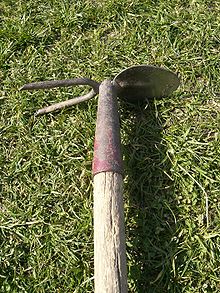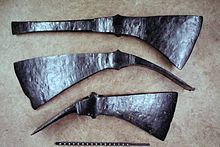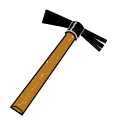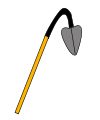Hoe (tool)
A hoe is a hand tool that is used to loosen and loosen the soil, especially when working the soil. There are numerous shapes and variants, for example pickaxes ( pickaxes ) or the karst with two or three prongs. Robust hoes are used for clearing . Upper German names for the hoe are Haue and (das) Häundl , (das) Heindl or (der) Krampen .
Construction and origin
As a rule, a hoe has a cross - leaf . At the rear end there is either an annular eyelet (the house ) or a socket into which the handle is inserted to accommodate the handle . In many designs with a house, the hoe blade is placed on the handle from the handle and is not fixed by counter wedges, but rather by widening the handle. Depending on the design and intended use, the handle is about 1.00 m to 1.40 m long, shorter for one-handed hoes and longer for field devices.
The original form of the hoe is the knee- shaped digging stick , which marks the beginning of hoe-building as the main form of agriculture .
Forerunner of the hoe:
a straight digging stickPharaoh Scorpion II
with a sharp field hoe, around 3100 BC Chr.Ancient Egyptian field hoe with a wide blade and a loop on the handle, British Museum
Field hoe for dense soils with an eyelet on the blade
(from the coat of arms of the village of Číměř nad Jihlavou , Czech Republic )
history
Hoes are Mesolithic tools. In archeology, this is usually used to describe devices that, unlike dechs, are made entirely of antlers or, less often, partly of bone, but also have a blade that is perpendicular to the shaft. Few blades are made from flint, but may mimic antler picks.
They were made from a pierced shoulder blade or a shovel of deer or elk antlers, the branches of which were removed. A hole serves as a socket for the handle.
In the Yangtze River Valley in China, hoes from the 5th millennium made of bones and polished stone were found, which are evidence of early agriculture. At the Kafiavana site in Melanesia , even 11,000 year old, polished and ground hoes were found, which were probably used to clear bushes.
Form, function and use

Field hoe in agriculture
As an agricultural implement, the hoe is also known as a field hoe , hoe or field hoe . The size and shape of the leaf depend on the intended use, in particular the "heaviness" and the stony of the soil . Regionally diverse forms and more precise names such as broad hoe have been used.
A small hoe blade is used to loosen “heavy” - i.e. loamy or clayey - soils, whereas a large and wide blade is used for loose and sandy soils such as a hoe or the comparable shuffle iron .
The hoe does not turn the soil - as it does with a spade or plow - but keeps its original layers .
Nowadays the hoe - apart from allotment gardening and the home garden - is mainly used as an agricultural tool only in developing countries; in industrialized countries it was mostly displaced by the plow , the tiller and the tiller .
Hoe in the clearing
In the clearance (the "Unterreuten") of shrubs , trees and vines the hoe is used in particular for removing the roots . A sturdy hoe is required as a hoe (or hoe ). The blade resembles that of an adze , the handle is long like an ax. Dialect names are Rod (e) haue , Radehacke (Saxon), Reuthacke , Reuthaue , Reute or Reithack .
Lifting hoe in the coat of arms of Rudersdorf , district of the rural community Buttstädt , Sömmerda district , Thuringia
Lifting hoe in the coat of arms of the municipality of Pingelshagen , Northwest Mecklenburg district , Mecklenburg-Western Pomerania
Pickaxe, pickaxe, hoopoe
The pickaxe is usually referred to as a pimple or a pickaxe. It can be as short as a hatchet or as long as an ax. Pickaxes have a point for hitting rock or ice, or for working in hard ground.
Often the blade on the other side is also shaped into a tool. There may be another spike there. Most of the time, however, the tip is faced with a differently shaped leaf . The most common form of the pickaxe is the pickaxe , also flat pickaxe or flat Kreuzhacke mentioned above German and staples (similar Czech krumpáč ). It has a point and opposite a flat cutting edge . The pickaxe is mainly used in earthworks and civil engineering to loosen stony and gravel soils.
The hoopoe (more rarely also the hoopoe ) has a transverse blade and - similar to an ax or a hatchet - a longitudinal blade; it is mainly used for work in deeply rooted soils. As a dolabra , this tool was used in the Roman army.
Special hoes for field and garden work

Hoes with two or three straight tines are called karst . The sow tooth is a hybrid: it has a single long, arched prong with a small leaf at the tip. The sow tooth and devices with multiple prongs and a similar function are also called cultivators . For earthing up traditionally served the Häufelhacke .
There are hoes with a strongly cranked neck or a steeply backward blade tip, also called scraper . For weeding was Schuffel developed in which the chopping blade is mounted horizontally.
Russian field hoe with triangular blade for lawns
Scharre (from the coat of arms of the city of Chrastava , Czech Republic )
Shuffle for weeding
heraldry
Since the hoe is the epitome of medieval conquest, many coats of arms contain hoes as a heraldic element. The hoe refers generally to agriculture or forest work ; when referring to clearing with reference to the emergence of a settlement, a hoe is often emblazoned . In the case of clearing names , the picture is "speaking". Individual hoes are related to metal processing ( tool forging ).
The tool is a " mean figure "; a preferred position in the escutcheon is not occupied. These representations are also interesting from a tool perspective, because they depict the regional forms.
The hoe as a coat of arms
- Region: Can be sorted according to NUTS , outside the EU ISO 3166 , so common regions can be put together.
- Blason: The blazon (the wording) is binding, the representation of freedom of the heraldist. Therefore the precise blazon is given where known.
- Penultimate column: name of the clearing (sorted by word stem, see the technical article)
- Last column: Form (booklet below); ⋂… rounded like a beaver tail; ♠ ... spade-shaped wide to pointed; ▲… tapering in the shape of a trowel to a narrow edge; ▐… long, narrow, pin-pointed or pimple-shaped blade; ■ ... undifferentiated broad; ▼ ... spatula or ax-shaped narrow tapering to a broad blade; 〪 ... shape indefinable
| coat of arms | carrier | region | Blason and Notes | ||
|---|---|---|---|---|---|
 |
Bachum | Hochsauerland NW | Hoe , golden, slanted | ♠ | |
 |
Bad Homburg vor der Höhe | Hochtaunus HE | ▐ | ||
 |
Bernitt | Rostock MV | Hoe , silver (crossed diagonally with an episcopal crook , below a ploughshare ) | ▼ | |
 |
Chaloupky | Beroun ST | Czech hornické motyky ('Bergmannshauen'), silver with a golden handle, crossed | ♠ | |
 |
Číměř nad Jihlavou | Třebíč VY | ▼ | ||
 |
Erdmannsweiler | Black Forest Baar BW |
? (crossed with a spade ) southwest German type with recessed edge, representation speaking (earthworking) |
■ | |
 |
Friedrichroda | Gotha TH | Hoe , silver with a black handle | * | ▲ |
 |
Hagen | Segeberg SH |
Hoe , silver (crossed diagonally with an ax ), strongly curved shape |
* | ■ |
 |
Haynrode | Eichsfeld TH | Hoe , golden | * | ♠ |
 |
Herald | Rhine-Lahn RP |
Red hoe hoes , crossed. Former place name: Herberod |
* | ♠ |
 |
Kefenrod | Wetterau HE | * | ♠ | |
 |
Langendorf | Burgenland ST | Hoe , silver, silver-handled (and a silver scythe ) | ♠ | |
 |
Langhagen | Rostock MV | Lifting hoes , golden, crossed diagonally | * | ■ |
 |
Lappi | Western Finland | ♠ | ||
 |
Loučná nad Desnou | Šumperk OL | czech motyky , golden | ▼ | |
 |
Marienheide | Oberbergischer Kreis NW | Lifting hoes , silver with golden stems, crossed | * | ▐ |
 |
Neusorg | District of Tirschenreuth BY | Reuthauen , black, crossed diagonally | ▐ | |
 |
Oberrod | Westerwald RP | Lifting hoe , silver | * | ▼ |
 |
Piippola | Northern Ostrobothnia | ♠ | ||
 |
Pingelshagen | Northwest Mecklenburg MV | Lifting hoe , black, overturned | * | ■ |
 |
Rammingen | Unterallgäu BY | Reuthauen , golden, crossed diagonally | ▐ | |
 |
Reinholterode | Eichsfeld TH | * | 〪 | |
 |
Rinchnach | District of Regen , Lower Bavaria BY | two diagonally crossed silver ticks with black handles | ▐ | |
 |
Rüti near Büren | Büren BE | Reuthau | * | ■ |
 |
Rudersdorf | Sömmerda TH | Lifting hoe , with black stem and blue leaf (with tree stump) | * | ♠ |
 |
Sora | Barcelona | spanish azada , catalan aixada , golden (crossed with a karst ) | ⋂ | |
 |
Weißenborn-Lüderode | Eichsfeld TH | * | ■ |
In Mecklenburg the hoe is also shown in the coats of arms of Möllenhagen and Rövershagen , in Rüttenen in the canton of Solothurn a Reuthaue is shown.
See also
- Adze , for woodworking
- Sapie , pointed hoe for forest work
- Double point (tool) , for stone processing
Web links
- Catalog with approx. 90 different designs (PDF; 2.1 MB) SHW Friedrichstal
Individual evidence
- ↑ Duden online: Hoe
- ↑ Duden online: Haue , Häundl , Heindl , Krampen
- ↑ Barry Cunliffe (Ed.): The Oxford Illustrated History. Illustrated prehistory and early history of Europe . Campus Verlag, Frankfurt am Main 1996, ISBN 3-593-35562-0 , p. 113-116 .
- ↑ Andrew Sherratt (Ed.): The Cambridge Encyclopedia of Archeology . Christian Verlag, Munich 1980, ISBN 3-88472-035-X , p. 144, 158, 325 .
- ↑ a b Rod (e) -hacke , WDW online dictionary 5.0, accessed on April 13, 2020.
- ↑ Das Roden ( Memento of the original from March 4, 2016 in the Internet Archive ) Info: The archive link was inserted automatically and has not yet been checked. Please check the original and archive link according to the instructions and then remove this notice. Grenchen Museum Society
- ^ Community of authors: Palatinate dictionary. Franz Steiner Verlag, Wiesbaden-Stuttgart 1965–1997
- ↑ a b cf. Motyka in the Polish language Wikipedia
- ↑ Heraldry of the World


















